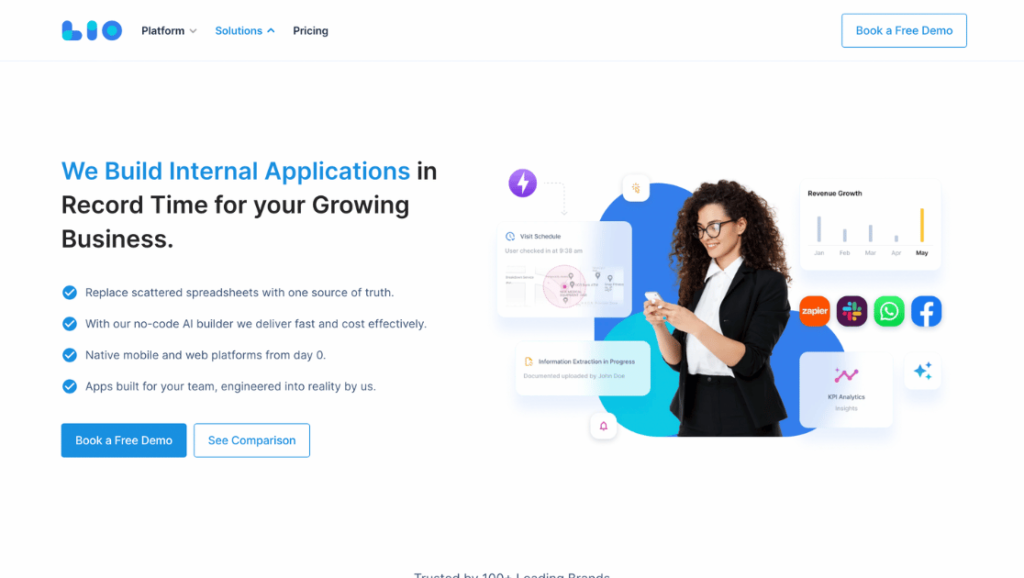Digital Transformation Strategy: Your Roadmap to Success
Gaurav Singh Rawat
- April 9, 2025
- 12 Min Read

As technology continues to reshape industries and consumer expectations, companies must adapt or risk becoming obsolete. A digital transformation strategy serves as a comprehensive roadmap, guiding businesses through the complex process of integrating digital technologies into all areas of their operations.
This strategic approach goes beyond merely implementing new tools; it involves fundamentally rethinking business models, processes, and organizational culture to leverage the full potential of digital innovations.
The importance of a well-crafted digital transformation strategy cannot be overstated. It enables companies to enhance customer experiences, streamline operations, boost productivity, and unlock new revenue streams.
However, developing and executing such a strategy is no small feat. It requires a deep understanding of emerging technologies, market trends, and organizational capabilities.
This article will explore the key components of a successful digital transformation strategy, offering insights into how businesses can navigate the challenges and opportunities presented by the digital revolution. By embracing digital transformation, companies can position themselves for long-term success in an increasingly competitive and technology-driven marketplace.
What is Digital Transformation Strategy?
A digital transformation strategy is a comprehensive plan that outlines how an organization will leverage digital technologies to fundamentally change its business operations, culture, and customer experiences.
As businesses navigate an increasingly digital landscape, having a well-defined strategy is crucial for success. This article explores the key components that form the foundation of an effective digital transformation strategy, providing a roadmap for organizations looking to thrive in the digital age.

Lead the Digital Shift
Stay ahead of the curve with our digital transformation services. We'll guide you through the process of adopting new technologies, optimizing processes, and creating a digital-first culture. Become a leader in your industry!
Key Components of a Digital Transformation Strategy
Digital transformation has become a critical imperative for organizations seeking to remain competitive and relevant. A well-crafted digital transformation strategy serves as a roadmap for leveraging cutting-edge technologies to revolutionize business operations, enhance customer experiences, and drive innovation.
This article explores the essential components that form the foundation of a successful digital transformation strategy, providing organizations with a framework to navigate the complexities of the digital age and unlock new opportunities for growth and success.
Vision and Goals
At the heart of any successful digital transformation strategy lies a clear vision and well-defined goals. These should be closely aligned with the overall business strategy to ensure cohesion across the organization. A digital transformation strategy must articulate a long-term vision for digital evolution, outlining how the company plans to leverage technology to drive growth and innovation.
Technology Assessment and Adoption
A critical component of a digital transformation strategy is the evaluation of current digital capabilities and the identification of new technologies to implement. This may include emerging technologies such as artificial intelligence, cloud computing, or the Internet of Things. The digital transformation strategy should outline a roadmap for adopting these technologies in a way that supports the organization’s goals.
Customer Experience Focus
In today’s digital age, customer experience is paramount. A robust digital transformation strategy must include a thorough analysis of the customer journey and all digital touchpoints. It should outline plans for enhancing digital customer interactions and leveraging technology to create seamless, personalized experiences across all channels.

Data and Analytics
Data is the lifeblood of digital transformation. A comprehensive digital transformation strategy should include strategies for leveraging data to gain insights and drive decision-making. This may involve implementing advanced analytics tools and artificial intelligence to extract meaningful insights from vast amounts of data.
Organizational Change Management
Digital transformation is not just about technology; it’s about people. A successful digital transformation strategy must include plans for managing organizational change. This includes strategies for shifting the company culture towards a digital mindset and implementing employee training and skill development programs to support the digital transformation journey.
Process Optimization
A key aspect of digital transformation is the optimization of business processes. A digital transformation strategy should identify processes that can be digitized or automated to improve efficiency. It should also outline plans for redesigning workflows to take full advantage of digital capabilities.
Innovation and Agility
To succeed in the digital age, organizations must foster a culture of innovation and agility. A digital transformation strategy should include frameworks for encouraging innovation across the organization and adopting agile methodologies to increase responsiveness to market changes.
How to Develop a Digital Transformation Strategy?
A digital transformation strategy is a comprehensive plan that outlines how an organization will leverage digital technologies to fundamentally change its business operations, culture, and customer experiences. Here are the key steps to develop an effective digital transformation strategy:

Modernize Your Business
Don't get left behind in the digital revolution. Our tailored digital transformation solutions will help you leverage cutting-edge technologies to boost efficiency, productivity, and competitiveness. Let's future-proof your business!
Assess Your Current Digital State
Before embarking on your digital transformation journey, it’s crucial to understand where your organization currently stands. This assessment should include:
– Evaluating existing digital capabilities and technologies
– Analyzing current business processes and workflows
– Identifying gaps in digital skills and resources
– Assessing your organization’s digital culture and readiness for change
Define Clear Objectives and Vision
Your digital transformation strategy should be aligned with your overall business goals. Clearly articulate:
– What you want to achieve through digital transformation
– How these objectives align with your business strategy
– The specific outcomes you expect from your digital initiatives
Identify Priority Areas and Initiatives
Based on your assessment and objectives, determine which areas of your business will benefit most from digital transformation. This may include:
– Customer experience enhancement
– Operational efficiency improvements
– New digital product or service development
– Data analytics and decision-making capabilities
Secure Leadership Buy-in and Build the Right Team
A successful digital transformation strategy requires strong leadership support and the right mix of skills. Ensure you:
– Get executive sponsorship and commitment
– Assemble a cross-functional team with diverse expertise
– Consider hiring or developing new digital talent
Choose Appropriate Technologies
Select technologies that align with your goals and fill capability gaps. Consider:
– Cloud computing platforms
– Artificial Intelligence and Machine Learning tools
– Internet of Things (IoT) solutions
– Data analytics and business intelligence software
What Are the Key Trends for Digital Transformation?
Here are 5 key trends for digital transformation with detailed information:

Increased Adoption of AI and Machine Learning
Artificial Intelligence (AI) and Machine Learning (ML) are becoming cornerstones of digital transformation strategies. According to Fortune Business Insights, the global AI market is projected to grow from $515.31 billion in 2023 to $2,025.12 billion by 2030, exhibiting a CAGR of 21.6%. AI and ML are being used to:
– Automate mundane tasks, saving time and reducing labor costs
– Provide data-driven insights for better decision-making
– Analyze customer data to create personalized experiences
– Enhance customer support through chatbots and virtual assistants
– Predict market trends and optimize pricing strategies
Focus on Cost Savings and Operational Efficiency
While digital transformation often aims at innovation, there’s an increasing emphasis on using it to drive cost savings and operational efficiency, especially in challenging economic climates. This trend manifests in two main ways:
– Optimizing cloud resources and eliminating redundant software licenses. For example, more than half of businesses SaaS licenses go unused, according to Productiv.
– Implementing process automation initiatives, with AI-based tools now capable of tackling a wider range of processes beyond just repetitive tasks.
Cloud Transformation and Hybrid Work Models
The shift towards cloud-based technologies and services continues to be a major trend, enabling greater scalability, flexibility, and data-sharing capabilities. This trend is closely tied to the rise of hybrid work models, which have become a significant factor in attracting and retaining talent. Key aspects include:
– Increased investment in cloud platforms and migration of mission-critical applications
– Focus on secure and efficient data sharing across distributed teams
– Development of flexible work environments that promote work-life balance

Digitize for Success
Take your business to the next level with digital transformation. Our expert team will help you integrate digital technologies, improve customer engagement, and create new revenue streams. Start your digital success story today!
Emphasis on Data Management and Analytics
As organizations collect more data than ever, there’s a growing focus on managing data throughout its lifecycle and leveraging analytics for better decision-making. This trend involves:
– Increased investment in business intelligence and data analytics tools
– Implementation of data governance frameworks
– Use of AI and ML for predictive analytics and real-time insights
Enhanced Cybersecurity Measures
As digital transformation progresses, cybersecurity is increasingly seen as a business imperative rather than an afterthought. This trend is characterized by:
– Increased IT budgets allocated to information security and cybersecurity
– Implementation of advanced security measures to address evolving business risks
– Integration of security considerations throughout the digital transformation process
How can Lio help in Digital Transformation
Lio can play a pivotal role in helping businesses transition from paper-based processes to a fully digital and automated environment. Here are some ways Lio can facilitate this digital transformation:

Centralized Data Management
Lio provides a platform where businesses can store all their data in a centralized digital repository. This eliminates the need for physical documents and allows for easy access, management, and sharing of information.
Customizable Templates
Lio offers a variety of customizable templates that can be tailored to fit the specific needs of different business processes. Whether it’s for inventory management, customer records, or financial tracking, these templates help digitize and streamline operations.
Real-Time Collaboration
The platform supports real-time collaboration, enabling multiple users to work on the same document simultaneously. This feature is particularly useful for teams that need to coordinate and update information frequently, reducing the reliance on paper-based communication.
Mobile Accessibility
Lio is accessible via mobile devices, allowing employees to input and access data from anywhere. This mobility ensures that business operations can continue smoothly without the constraints of physical paperwork.

Go Paperless Today
Transform your business with Lio. Digitize your documents and workflows to eliminate paper clutter and boost efficiency. Start your paperless journey now!
Secure Document Management
Lio provides robust security features to protect sensitive business data. Documents can be locked to prevent unauthorized edits, and access can be controlled through user permissions, ensuring that only authorized personnel can view or modify critical information.
Automated Workflows
The platform supports the creation of automated workflows, which can replace manual, paper-based processes. For example, approval processes, data entry, and reporting can be automated, reducing the time and effort required to manage these tasks manually.
Integration with Existing Systems
Lio can integrate with over 100 existing applications, allowing businesses to connect their new digital solutions with current systems. This seamless integration ensures that the transition to a paperless environment does not disrupt existing workflows.
Conclusion
Application modernization delivers a multitude of benefits, from improved performance and user experiences to enhanced security, reduced costs, and faster time-to-market. However, it also presents challenges such as high migration costs, skill gaps, complexity, and change resistance.
To succeed in their modernization journeys, enterprises must carefully assess their application portfolios, choose the right modernization approaches, and adopt best practices in areas like cloud migration, microservices, DevOps, and automation. Partnering with experienced service providers and utilizing cutting-edge tools and platforms can accelerate the process while mitigating risks.
As technology continues to evolve at a rapid pace, enterprise application modernization is not a one-time event but an ongoing process. Organizations must cultivate a culture of continuous modernization, staying attuned to emerging trends and customer needs. By doing so, they can build a strong, adaptable foundation for long-term growth and success in the ever-changing digital landscape.
Frequently Asked Questions (FAQs)
How long does it typically take to implement a digital transformation strategy?
The timeline for implementing a digital transformation strategy can vary greatly depending on the organization’s size, complexity, and goals. Generally, it can take anywhere from 1-5 years for full implementation, with some initial results visible within the first 6-12 months.
What is the role of leadership in a digital transformation strategy?
Leadership plays a crucial role in digital transformation. They need to set the vision, drive cultural change, allocate resources, and champion the transformation across the organization. Without strong leadership support, digital transformation efforts are likely to fail.
How can companies measure the ROI of their digital transformation strategy?
Companies can measure ROI through various metrics such as increased revenue, improved customer satisfaction scores, reduced operational costs, faster time-to-market for new products/services, and improved employee productivity. It’s important to establish baseline metrics before transformation and track progress over time.
What are some common pitfalls to avoid when implementing a digital transformation strategy?
Common pitfalls include focusing too much on technology and not enough on people and processes, failing to communicate effectively across the organization, underestimating the scale of change required, and not aligning digital initiatives with overall business strategy.
How does a digital transformation strategy impact customer acquisition and retention?
A successful digital transformation strategy can significantly improve customer acquisition and retention by enhancing customer experiences, enabling personalized interactions, providing better products/services, and creating new digital touchpoints for engagement.
What role does artificial intelligence (AI) play in a digital transformation strategy?
AI can be a key enabler in digital transformation, helping to automate processes, provide predictive analytics, enhance decision-making, personalize customer experiences, and create new AI-driven products and services.


